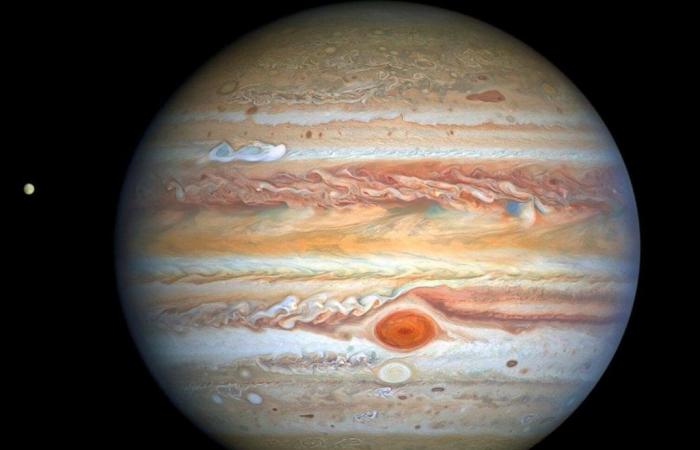One of the facts that is usually remembered from school science classes is that Jupiter is the largest planet in the solar system. Its dimensions are colossal: 1,300 earths could fit inside, its diameter is 318 times greater than the … The giant is much larger than our planet and its mass is so enormous that if the masses of the other planets in the solar system were combined into one, the mass of the giant would still be about 2.5 times greater. In addition to its size, there is another characteristic that makes it very recognizable: the so-called Great Red Spot, a large anticyclone in its southern hemisphere visible even with small telescopes. Experts from the University of the Basque Country have participated in a study that has determined both its dimensions and its age and formation. “It currently has the diameter of the Earth and was formed 190 years ago,” explains Agustín Sánchez-Lavega, professor of Physics at the UPV/EHU who led the work, published in the journal ‘Geophysical Research Letters’.
The Great Red Spot (GRS) is a huge anticyclone “like the one in the Azores” around which winds blow at 450 kilometres per hour. “It is the largest and longest-lived vortex of all those existing in the atmospheres of the planets in the solar system,” adds the expert from the Basque university. The study, which began before the pandemic, has had a double aspect. On the one hand, historical research, compiling the drawings and photographs that exist of this vortex. “It has been a very nice job,” Lavega acknowledges. And, on the other, computer simulations to describe how it was formed.
The first observations date back to 1665, when the Italian-French astronomer Giovanni Domenico Cassini discovered a “dark oval” that he named ‘Permanent Spot’ (PS, in its initials in English). Its trace was lost for 118 years until in 1831 it was detected again at the same latitude where it is located today. «It can be considered the first observation of the current Great Red Spot, perhaps from the moment it began to form. From the measurements of sizes and movements we deduce that it is highly unlikely that the current one was the one observed by Cassini. “The latter probably disappeared sometime between the mid-18th and 19th centuries.” This would imply that he is at least 190 years old.
On the left, an image taken on October 14, 1890. On the right, a photograph from January 5, 2024. In this case, the spot is seen in the northern hemisphere because telescopes invert the image.
BDIP-Observatoire Paris and HST/NASA/ESA/OSAL PROGRAM
Theories about its formation
Its size from 1879 to the present has been decreasing. It is known that on the first date it measured 39,000 kilometers along its longest axis compared to the 14,000 kilometers it has now. In addition, its shape has been rounded. Thanks to NASA’s Juno mission, it is known that it extends vertically about 500 kilometers, “so it is shallow and thin compared to its extension.”
Although it is an anticyclone like the one in the Azores on a gigantic scale, its formation is not the same. There are three theories that they have handled together with experts from the Universitat Politècnica de Catalunya – BarcelonaTech (UPC) and the Barcelona Supercomputing Center and that they have simulated on the MareNostrum IV supercomputer, one of the most powerful in the country. The first is that “it was the result of a superstorm similar to those that have rarely been observed on Saturn, but would give rise to an anticyclone smaller than the Great Spot. The second addresses the option that it would have originated from the merger of several smaller anticyclones, “something that has not been observed on Jupiter.”
The third explanation, the most plausible, is that it was generated by a well-known instability of the winds on Jupiter, which “would be capable of generating an elongated cell that encloses and traps them. The Great Spot is framed both to the north and to the south by two large currents of winds of 180 km/h and 150 km/h that circulate in opposite directions. Sometimes, these curve and the one to the north goes down to the south, and this one follows the opposite path. This cell would thus be formed, which would be a proto-GRS, a nascent red spot, whose subsequent shrinkage would give rise to the compact and rapidly rotating GRS observed at the end of the 19th century.”
What remains to be seen is the reason for the shrinkage over the past 150 years and whether it will eventually disappear when it reaches a certain size, as may have happened with the spot detected by Cassini, or whether it will persist over time.






